Extreme Temperature Events during 1960–2017 in the Arid Region of Northwest China: Spatiotemporal Dynamics and Associated Large-Scale Atmospheric Circulation
Abstract
:1. Introduction
2. Data and Methodology
2.1. Study Area
2.2. Data
2.3. Methods
3. Results
3.1. Temporal Trends of Extreme Temperature Indices
3.1.1. Extreme Warm Indices: SU25, TX90p, TN90p, and Warm Spell Duration Indicator (WSDI)
3.1.2. Extreme Cold Indices: FD, TX10p, TN10p, and Cold Spell Duration Indicator (CSDI)
3.2. Spatial Trends of Extreme Temperature Indices
3.2.1. Temperature Indices Based on Absolute Threshold: FD, SU25
3.2.2. Temperature Indices Based on Percentile Threshold: TX10p, TN10p, TX90p, and TN90p
3.2.3. Consecutive Day Temperature Indices: CSDI, and WSDI
4. Breaking-Point Change of Extreme Temperature Indices
5. Discussion and Conclusions
Author Contributions
Funding
Acknowledgments
Conflicts of Interest
Appendix A
| Number | Station Name | Province | Latitude | Longitude | ELEVATION (m) |
|---|---|---|---|---|---|
| 51053 | Habahe | Xinjiang | 48.05 | 86.40 | 532.6 |
| 51060 | Buerjin | Xinjiang | 47.42 | 86.52 | 473.9 |
| 51068 | Fuhai | Xinjiang | 47.12 | 87.47 | 500.9 |
| 51076 | Altai | Xinjiang | 47.73 | 88.08 | 735.3 |
| 51087 | Fuyun | Xinjiang | 46.59 | 89.31 | 807.5 |
| 51133 | Tacheng | Xinjiang | 46.73 | 83.00 | 534.9 |
| 51156 | Hebukesaier | Xinjiang | 46.78 | 85.72 | 1291.6 |
| 51186 | Qinghe | Xinjiang | 46.67 | 90.38 | 1218.2 |
| 51232 | Alashankou | Xinjiang | 45.18 | 82.57 | 336.1 |
| 51238 | Bole | Xinjiang | 44.54 | 82.04 | 532.2 |
| 51241 | Tuoli | Xinjiang | 45.93 | 83.60 | 1077.8 |
| 51243 | Kelamayi | Xinjiang | 45.62 | 84.85 | 449.5 |
| 51288 | Beitashan | Xinjiang | 45.37 | 90.53 | 1653.7 |
| 51330 | Wenquan | Xinjiang | 44.97 | 81.02 | 1357.8 |
| 51334 | Jinghe | Xinjiang | 44.62 | 82.90 | 329.2 |
| 51346 | Wusu | Xinjiang | 44.43 | 84.67 | 478.7 |
| 51365 | Caijiahu | Xinjiang | 44.20 | 87.53 | 440.5 |
| 51379 | Qitai | Xinjiang | 44.02 | 89.57 | 793.5 |
| 51431 | Yining | Xinjiang | 43.95 | 81.33 | 662.5 |
| 51433 | Nileke | Xinjiang | 43.80 | 82.57 | 1105.3 |
| 51437 | Zhaosu | Xinjiang | 43.15 | 81.13 | 1851 |
| 51463 | Urumqi | Xinjiang | 43.78 | 87.65 | 935 |
| 51467 | Baluntai | Xinjiang | 42.73 | 86.30 | 1732.4 |
| 51470 | Tianchi | Xinjiang | 43.53 | 88.07 | 1942.5 |
| 51477 | Dabancheng | Xinjiang | 43.35 | 88.32 | 1103.5 |
| 51495 | Qijiaojing | Xinjiang | 43.22 | 91.73 | 721.4 |
| 51526 | Kumishi | Xinjiang | 42.23 | 88.22 | 922.4 |
| 51542 | Bayinbuluke | Xinjiang | 43.03 | 84.15 | 2458 |
| 51567 | Yanqi | Xinjiang | 42.08 | 86.57 | 1055.3 |
| 51573 | Turpan | Xinjiang | 42.93 | 89.20 | 34.5 |
| 51581 | Shanshan | Xinjiang | 42.85 | 90.23 | 398.6 |
| 51628 | Akesu | Xinjiang | 41.17 | 80.23 | 1103.8 |
| 51633 | Baicheng | Xinjiang | 41.78 | 81.90 | 1229.2 |
| 51639 | Shaya | Xinjiang | 41.14 | 82.47 | 980.4 |
| 51642 | Luntai | Xinjiang | 41.78 | 84.25 | 982 |
| 51644 | Kuche | Xinjiang | 41.72 | 82.97 | 1081.9 |
| 51656 | Kuerle | Xinjiang | 41.75 | 86.13 | 931.5 |
| 51701 | Tuergate | Xinjiang | 40.52 | 75.40 | 3504.4 |
| 51704 | Atushi | Xinjiang | 39.43 | 76.10 | 1298.7 |
| 51705 | Wuqia | Xinjiang | 39.72 | 75.25 | 2175.7 |
| 51709 | Kashgar | Xinjiang | 39.47 | 75.98 | 1385.6 |
| 51711 | Aheqi | Xinjiang | 40.93 | 78.45 | 1985.1 |
| 51716 | Bachu | Xinjiang | 39.80 | 78.57 | 1116.5 |
| 51720 | Keping | Xinjiang | 40.50 | 79.05 | 1161.8 |
| 51730 | Alaer | Xinjiang | 40.55 | 81.27 | 1012.2 |
| 51765 | Tieganlike | Xinjiang | 40.63 | 87.70 | 846 |
| 51777 | Ruoqiang | Xinjiang | 39.03 | 88.17 | 887.7 |
| 51804 | Tashikuergan | Xinjiang | 37.77 | 75.23 | 3090.1 |
| 51810 | Maigaiti | Xinjiang | 38.55 | 77.38 | 1178.2 |
| 51811 | Shache | Xinjiang | 38.43 | 77.27 | 1231.2 |
| 51818 | Pishan | Xinjiang | 37.62 | 78.28 | 1375.4 |
| 51828 | Hetian | Xinjiang | 37.13 | 79.93 | 1375 |
| 51839 | Minfeng | Xinjiang | 37.07 | 82.72 | 1409.5 |
| 51855 | Qiemo | Xinjiang | 38.15 | 85.55 | 1247.2 |
| 51931 | Yutian | Xinjiang | 36.85 | 81.65 | 1422 |
| 52101 | Balitang | Xinjiang | 43.60 | 93.05 | 1679.4 |
| 52112 | Zhuomaohu | Xinjiang | 43.45 | 94.59 | 479 |
| 52118 | Yiwu | Xinjiang | 43.16 | 94.42 | 1728.6 |
| 52203 | Hami | Xinjiang | 42.82 | 93.52 | 737.2 |
| 52313 | Hongliuhe | Xinjiang | 41.53 | 94.67 | 1573.8 |
| 52323 | Mazongshan | Gansu | 41.80 | 97.03 | 1770.4 |
| 52418 | Dunhuang | Gansu | 40.15 | 94.68 | 1139 |
| 52424 | Anxi | Gansu | 40.53 | 95.77 | 1170.9 |
| 52436 | Yumenzhen | Gansu | 40.27 | 97.03 | 1526 |
| 52446 | Dingxin | Gansu | 40.30 | 99.52 | 1177.4 |
| 52447 | Jinta | Gansu | 40.00 | 98.90 | 1270.5 |
| 52495 | Bayinmaodao | Inner Mongolia | 40.17 | 104.80 | 1323.9 |
| 52533 | Jiuquan | Gansu | 39.77 | 98.48 | 1477.2 |
| 52546 | Gaotai | Gansu | 39.37 | 99.83 | 1332.2 |
| 52576 | Alashanyouqi | Inner Mongolia | 39.22 | 101.68 | 1510.1 |
| 52633 | Tuole | Qinghai | 38.80 | 98.42 | 3367 |
| 52645 | Yeniugou | Qinghai | 38.42 | 99.58 | 3314 |
| 52652 | Zhangye | Gansu | 38.93 | 100.43 | 1461.1 |
| 52657 | Qilian | Qinghai | 38.18 | 100.25 | 2787.4 |
| 52661 | Shandan | Gansu | 38.80 | 101.08 | 1765.5 |
| 52674 | Yongchang | Gansu | 38.23 | 101.97 | 1976.9 |
| 52679 | Wuwei | Gansu | 37.92 | 102.67 | 1531.5 |
| 52681 | Minqin | Gansu | 38.63 | 103.08 | 1367.5 |
| 52787 | Wuqiaoling | Gansu | 37.20 | 102.87 | 3045.1 |
| 52797 | Jingtai | Gansu | 37.18 | 104.05 | 1630.9 |
| 53502 | Jilantai | Inner Mongolia | 39.78 | 105.75 | 11031.8 |
| 53519 | Huinong | Ningxia | 39.22 | 106.77 | 1092.5 |
| 53602 | Alashanzuoqi | Inner Mongolia | 38.83 | 105.67 | 1561.4 |
| 53614 | Yinchuan | Ningxia | 38.48 | 106.22 | 1110.9 |
| 53615 | Taole | Ningxia | 38.80 | 106.70 | 1101.6 |
| 53705 | Zhongning | Ningxia | 37.48 | 105.68 | 1183.4 |
| 52378 | Guaizihu | Inner Mongolia | 41.37 | 102.37 | 960 |
References
- Doktycz, C.; Abkowitz, M. Loss and Damage Estimation for Extreme Weather Events: State of the Practice. Sustainability 2019, 11, 4243. [Google Scholar] [CrossRef] [Green Version]
- Vincent, L.A.; Peterson, T.C.; Barros, V.R.; Marino, M.B.; Rusticucci, M.; Carrasco, G.; Ramirez, E.; Alves, L.M.; Ambrizzi, T.; Berlato, M.A.; et al. Observed trends in indices of daily temperature extremes in South America 1960–2000. J. Clim. 2005, 18, 5011–5023. [Google Scholar] [CrossRef]
- Choi, G.; Collins, D.; Ren, G.Y.; Trewin, B.; Baldi, M.; Fukuda, Y.; Afzaal, M.; Pianmana, T.; Gomboluudev, P.; Huong, P.T.T.; et al. Changes in means and ex-treme events of temperature and precipitation in the Asia-Pacific Network region, 1955–2007. Int. J. Climatol. 2009, 29, 1906–1925. [Google Scholar] [CrossRef]
- Mutiibwa, D.; Vavrus, S.J.; McAfee, S.A.; Albright, T.P. Recent spatiotemporal patterns in temperature extremes across conterminous United States. J. Geophys. Res.-Atmos. 2015, 120, 7378–7392. [Google Scholar] [CrossRef]
- Centre for Research on the Epidemiology of Disasters (CRED), United Nations Office for Disaster Risk Reduction (UNISDR). The Human Cost of Weather-Related Disasters 1995–2015; UNISDR: Geneva, Switzerland, 2015; Volume 30. [Google Scholar]
- Robine, J.M.; Cheung, S.L.K.; Le Roy, S.; Van Oyen, H.; Griffiths, C.; Michel, J.P.; Herrmann, F.R. Death toll exceeded 70,000 in Europe during the summer of 2003. C. R. Biol. 2008, 331, 171–178. [Google Scholar] [CrossRef] [PubMed]
- Garcia-Herrera, R.; Diaz, J.; Trigo, R.M.; Luterbacher, J.; Fischer, E.M. A review of the European summer h-eat wave of 2003. Crit. Rev. Environ. Sci. Technol. 2010, 40, 267–306. [Google Scholar] [CrossRef]
- Wolfgang, K.; Petra, L.; Zbigniew, W.K. Changes in risk of extreme weather events in Europe. Environ. Sci. Policy 2019, 100, 74–83. [Google Scholar] [CrossRef]
- Zhang, S.; Tao, F.L.; Zhang, Z. Changes in extreme temperatures and their impacts on rice yields in southern China from 1981 to 2009. Field. Crops Res. 2016, 189, 43–50. [Google Scholar] [CrossRef] [Green Version]
- Huang, W.C.; Lee, Y.Y. Strategic Planning for Land Use under Extreme Climate Changes: A Case Study in Taiwan. Sustainability 2016, 8, 53. [Google Scholar] [CrossRef] [Green Version]
- Hatfeld, J.L.; Prueger, J.H. Temperature extremes: Effect on plant growth and development. Weather Clim. Extrem. 2015, 10, 4–10. [Google Scholar] [CrossRef] [Green Version]
- Crabbe, R.A.; Dash, J.; Rodriguez-Galiano, V.F.; Janous, D.; Pavelka, M.; Marek, M.V. Extreme warm temperatures alter forest phe-nology and productivity in Europe. Sci. Total. Environ. 2016, 563–564, 486–495. [Google Scholar] [CrossRef] [PubMed]
- Li, C.; Wang, J.; Hu, R.; Yin, S.; Bao, Y.; Ayal, D.Y. Relationship between vegetation change and extreme climate in-dices on the Inner Mongolia Plateau, China, from 1982 to 2013. Ecol. Indic. 2018, 89, 101–109. [Google Scholar] [CrossRef]
- Ye, L.; Shi, K.; Xin, Z.; Wang, C.; Zhang, C. Compound Droughts and Heat Waves in China. Sustainability 2019, 11, 3270. [Google Scholar] [CrossRef] [Green Version]
- Bala, G.; Caldeira, K.; Nemani, R. Fast versus slow response in climate change: Implications for the global hydrological cycle. Clim. Dyn. 2010, 35, 423–434. [Google Scholar] [CrossRef]
- Kao, L.S.; Chiu, Y.H.; Tsai, C.Y. An Evaluation Study of Urban Development Strategy Based on of Extreme Climate Conditions. Sustainability 2017, 9, 284. [Google Scholar] [CrossRef] [Green Version]
- Zhang, H.; Wang, Y.; Park, T.W.; Deng, Y. Quantifying the relationship between extreme air pollution events and extreme weather events. Atmos. Res. 2017, 188, 64–79. [Google Scholar] [CrossRef]
- Sanz-Lazaro, C. A Framework to Advance the Understanding of the Ecological Effects of Extreme Climate Events. Sustainability 2019, 11, 5954. [Google Scholar] [CrossRef] [Green Version]
- Rammig, A.; Mahecha, M.D. Ecosystem responses to climate extremes. Nature 2015, 527, 315–316. [Google Scholar] [CrossRef]
- Yang, Z.M.; Wang, Q.; Liu, P.F. Extreme temperature and mortality: Evidence from China. Int. J. Biometeorol. 2018, 63, 29–50. [Google Scholar] [CrossRef]
- Orimoloye, I.R.; Mazinyo, S.P.; Kalumba, A.M.; Ekundayo, O.Y.; Nel, W. Implications of climate variability and change on urban and human health: A review. Cities 2019, 91, 213–223. [Google Scholar] [CrossRef]
- Mernild, S.H.; Hanna, E.; Yde, J.C.; Cappelen, J.; Malmros, J.K. Coastal Greenland air temperature extremes and trends 1890–2010: Annual and monthly analysis. Int. J. Climatol. 2014, 34, 1472–1487. [Google Scholar] [CrossRef]
- Barrett, B.; Charles, J.W.; Temte, J.L. Climate change, human health, and epidemiological transition. Prev. Med. 2015, 70, 69–75. [Google Scholar] [CrossRef] [Green Version]
- Trenberth, K.E.; Fasullo, J.T. Climate extremes and climate change: The Russian heat wave and ot-her climate extremes of 2010. J. Geophys. Res.-Atmos. 2012, 117, 17103. [Google Scholar] [CrossRef]
- Wijngaarden, V.W.A. Temperature trends in the Canadian arctic during 1895–2014. Theor. Appl. Climatol. 2015, 120, 609–615. [Google Scholar] [CrossRef]
- Zhang, X.B.; Aguilar, E.; Sensoy, S. Trends in Middle East climate extreme indices from 1950 to 2003. J. Geophys. Res. 2005, 110, 3159–3172. [Google Scholar] [CrossRef]
- Scaife, A.A.; Folland, C.K.; Alexander, L.V.; Moberg, A.; Knight, J.R. European climate extremes and the North Atlantic Oscillation. J. Clim. 2008, 21, 72–83. [Google Scholar] [CrossRef]
- New, M.; Hewitson, B.; Stephenson, D.B.; Tsiga, A.; Kruger, A.; Manhique, A.; Mbambalala, E. Evidence of trends in daily climate extremes over southern and west Africa. J. Geophys. Res.-Atmos. 2006, 111, 3007–3021. [Google Scholar] [CrossRef]
- Rupa Kumar, K.; Krishna Kumar, K.; Pant, G.B. Diurnal asymmetry of surface temperature trends over India. Geophys. Res. Lett. 1994, 21, 677–680. [Google Scholar] [CrossRef]
- Kothawale, D.R.; Rupa Kumar, K. On the recent changes in surface temperature trends over India. Geophys. Res. Lett. 2005, 32, L18714. [Google Scholar] [CrossRef]
- Frich, P.; Alexander, L.V.; Della-Marta, P.; Gleason, B.; Haylock, M.; Tank, A.M.G. Observed coherent changes in climatic extremes during 2nd half of the 20th century. Clim. Res. 2002, 19, 193–212. [Google Scholar] [CrossRef] [Green Version]
- Alexander, L.V.; Zhang, X.B.; Peterson, T.C.; Caesar, J.; Vazquez-Aguirre, J.L. Global observed changes in daily climate extremes of temperature and precipitation. J. Geophys. Res.-Atmos. 2006, 111, 1042–1063. [Google Scholar] [CrossRef] [Green Version]
- Brown, S.J.; Caesar, J.; Ferro, C.A.T. Global changes in extreme daily temperature since 1950. J. Geophys. Res.-Atmos. 2008, 113, D05115. [Google Scholar] [CrossRef] [Green Version]
- Kenyon, J.; Hegerl, G.C. Influence of modes of climate variability on global temperature extremes. J. Clim. 2008, 21, 3872–3889. [Google Scholar] [CrossRef]
- Lelieveld, J.; Proestos, Y.; Hadjinicolaou, P.; Tanarhte, M.; Tyrlis, E.; Zittis, G. Strongly increasing heat extremes in the Middle East and North Africa (MENA) in the 21st century. Clim. Chang. 2016, 137, 245–260. [Google Scholar] [CrossRef] [Green Version]
- Zhong, K.; Zheng, F.; Wu, H.; Qin, C.; Xu, X. Dynamic changes in temperature extremes and their association with atmospheric circulation patterns in the Songhua River Basin, China. Atmos. Res. 2017, 190, 77–88. [Google Scholar] [CrossRef]
- Christidis, N.; Stott, P.A.; Brown, S.; Hegerl, G.C.; Caesar, J. Detection of changes in temperature extremes during the second half of the 20th century. Geophys. Res. Lett. 2005, 32, 242–257. [Google Scholar] [CrossRef] [Green Version]
- Tao, H.; Fraedrich, K.; Menz, C.; Zhai, J. Trends in extreme temperature indices in the Poyang Lake Basin, China. Stoch. Environ. Res. Risk A 2014, 28, 1543–1553. [Google Scholar] [CrossRef]
- Wang, X.L.; Hou, X.Y. Analysis of spatiotemporal variations and regional differences in extreme temperature events in the coastal area of China during 1961–2014. Acta Ecol. Sin. 2017, 37, 7098–7113. [Google Scholar] [CrossRef]
- Liu, B.; Xu, M.; Henderson, M.; Qi, Y.; Li, Y. Taking China’s temperature: Daily range, warming trends, and regional variations, 1955–2000. J. Clim. 2004, 17, 4453–4462. [Google Scholar] [CrossRef]
- You, Q.; Kang, S.; Aguilar, E.; Pepin, N.; Flugel, W.A.; Yan, Y.; Xu, Y.; Zhang, Y.; Huang, J. Changes in daily climate extremes in China and their connection to the large-scale atmospheric circulation during 1961–2003. Clim. Dyn. 2011, 36, 2399–2417. [Google Scholar] [CrossRef]
- Shi, J.; Cui, L.L.; Ma, Y.; Du, H.Q.; Wen, K.G. Trends in temperature extremes and their associati-on with circulation patterns in china during 1961–2015. Atmos. Res. 2018, 212, 259–272. [Google Scholar] [CrossRef]
- Tong, S.; Li, X.; Zhang, J.; Bao, Y.; Bao, Y.; Na, L.; Si, A. Spatial and temporal variability in extreme temperature and precipitation events in Inner Mongolia (China) during 1960–2017. Sci. Total Environ. 2019, 649, 75–89. [Google Scholar] [CrossRef] [PubMed]
- Sun, W.Y.; Mu, X.M.; Song, X.Y.; Wu, D.; Cheng, A.F.; Qiu, B. Changes in extreme temperature and precipitation events in the Loess Plateau (China) during 1960–2013 under global warming. Atmos. Res. 2016, 168, 33–48. [Google Scholar] [CrossRef]
- Yan, G.; Qi, F.; Wei, L.; Aigang, L.; Yu, W.; Jing, Y.; Aifang, C.; Yamin, W.; Yubo, S.; Li, L.; et al. Changes of daily climate extremes in Loess Plateau during 1960–2013. Quat. Int. 2015, 371, 5–21. [Google Scholar] [CrossRef]
- Yu, Z.; Li, X.L. Recent trends in daily temperature extremes over northeastern China (1960–2011). Quat. Int. 2015, 380–381, 35–48. [Google Scholar] [CrossRef]
- Li, Z.; He, Y.; Wang, C.; Wang, X.; Xin, H.; Zhang, W.; Cao, W. Spatial and temporal trends of temperature and precipitation during 1960–2008 at the Hengduan Mountains, China. Quat. Int. 2011, 236, 127–142. [Google Scholar] [CrossRef]
- Qian, Z.A.; Wu, T.; Song, M.; Ma, X.; Cai, Y.; Liang, X. Arid disaster and advances in arid climate resources over northwest China. Adv. Earth. Sci. 2001, 16, 28–38. (In Chinese) [Google Scholar]
- Shi, Y.; Shen, Y.; Kang, E.; Li, D.; Ding, Y.; Zhang, G.; Hu, R. Recent and Future Climate Change in Northwest China. Clim. Chang. 2007, 80, 379–393. [Google Scholar] [CrossRef]
- Jiang, C.; Liu, J.; Zhang, H.; Zhang, Z.; Wang, D. China’s progress towards sustainable land degradation control: Insights from the northwest arid regions. Ecol. Eng. 2019, 127, 75–87. [Google Scholar] [CrossRef]
- Yao, J.; Tuoliewubieke, D.; Chen, J.; Huo, W.; Hu, W.F. Identification of drought events and correlations with large-Scale ocean-atmospheric patterns of variability: A case study in Xinjiang, China. Atmosphere 2019, 10, 94. [Google Scholar] [CrossRef] [Green Version]
- Jiang, X.F.; Li, W.; You, Q.L. Probability projection and uncertainties of the temperature extreme indices change over China. Clim. Chang. Res. 2018, 14, 228–236. [Google Scholar] [CrossRef]
- Zhang, Q.; Singh, V.P.; Li, J.; Jiang, F.; Bai, Y. Spatio-temporal variations of precipitation extremes in Xinjiang, China. J. Hydrol. 2012, 434–435, 7–18. [Google Scholar] [CrossRef]
- Wang, H.; Chen, Y.; Xun, S.; Lai, D.; Fan, Y.; Li, Z. Changes in daily climate extremes in the arid area of northwestern China. Theor. Appl. Climatol. 2013, 112, 15–28. [Google Scholar] [CrossRef]
- Deng, H.J.; Chen, Y.N.; Shi, X.; Li, W.H.; Wang, H.J.; Zhang, S.H.; Fang, G.H. Dynamics of temperature and precipitation extremes and their spatial variation in the arid region of northwest China. Atmos. Res. 2014, 138, 346–355. [Google Scholar] [CrossRef]
- Chen, Y.; Deng, H.; Li, B.; Li, Z.; Xu, C. Abrupt change of temperature and precipitation extremes in the arid region of Northwest China. Quat. Int. 2014, 336, 35–43. [Google Scholar] [CrossRef]
- Martínez, M.D.; Serra, C.; Burgueño, A.; Lana, X. Time trends of daily maximum and minimum temperatures in Catalonia (ne Spain) for the period 1975–2004. Int. J. Climatol. 2010, 30, 267–290. [Google Scholar] [CrossRef] [Green Version]
- Ullah, S.; You, Q.; Ullah, W.; Ali, A.; Xie, W.; Xie, X. Observed changes in temperature extremes over China–Pakistan Economic Corridor during 1980–2016. Int. J. Climatol. 2018, 39, 1457–1475. [Google Scholar] [CrossRef]
- You, Q.L.; Ren, G.Y.; Fraedrich, K.; Kang, S.C.; Ren, Y.Y.; Wang, P.L. Winter temperature extremes in China and their possible causes. Int. J. Climatol. 2013, 33, 1444–1455. [Google Scholar] [CrossRef]
- Guan, Y.H.; Zhang, X.C.; Zheng, F.L.; Wang, B. Trends and variability of daily temperature extremes during 1960–2012 in the Yangtze River Basin, China. Glob. Planet Chang. 2015, 124, 79–94. [Google Scholar] [CrossRef] [Green Version]
- Rahimi, M.; Hejabi, S. Spatial and temporal analysis of trends in extreme temperature indices in Iran over the period 1960–2014. Int. J. Climatol. 2017, 38, 272–282. [Google Scholar] [CrossRef]
- Mann, H.B. Non-parametric tests against trend. Econometrica 1945, 13, 245–259. [Google Scholar] [CrossRef]
- Sen, P.K. Estimates of the regression coefficient based on Kendall’s tau. J. Am. Stat. Assoc. 1968, 63, 1379–1389. [Google Scholar] [CrossRef]
- Yue, S.; Wang, C. The Mann–Kendall test modified by effective sample size to detect trend in serially correlated hydrological series. Water Resour. Manag. 2004, 18, 201–218. [Google Scholar] [CrossRef]
- Dansgaard, W.; Clausen, H.B.; Gundestrup, N.; Hammer, C.U.; Johnsen, S.F.; Kristinsdottir, P.M.; Reeh, N. A new greenland deep ice core. Science 1982, 218, 1273–1277. [Google Scholar] [CrossRef] [PubMed]
- Wang, H.J.; Pan, Y.P.; Chen, Y.N.; Ye, Z.W. Linear trend and abrupt changes of climate indices in the arid region of northwestern China. Atmos. Res. 2017, 196, 108–118. [Google Scholar] [CrossRef]
- Wang, B.; Zhang, M.; Wei, J.; Wang, S.; Li, S.; Ma, Q.; Li, X.; Pan, S. Changes in extreme events of temperature and precipitation over Xinj-iang northwest China, during 1960–2009. Quat. Int. 2013, 298, 141–151. [Google Scholar] [CrossRef]
- Renom, M.; Rusticucci, M.; Barreiro, M. Multidecadal changes in the relationship between extreme temperature events in Uruguay and the general atmospheric circulation. Clim. Dyn. 2011, 37, 2471–2480. [Google Scholar] [CrossRef] [Green Version]
- Hong, C.C.; Wu, Y.K.; Li, T.; Chang, C.C. The climate regime shift over the Pacifc during 1996/1997. Clim. Dyn. 2014, 43, 435–446. [Google Scholar] [CrossRef] [Green Version]
- Yan, P.C.; Hou, W.; Feng, G.L. Transition process of abrupt climate change based on global sea s-urface temperature over the past century. Nonlinear Proc. Geophys. 2016, 23, 115–126. [Google Scholar] [CrossRef] [Green Version]
- Dong, B.W.; Sutton, R.T.; Chen, W.; Liu, X.D.; Lu, R.Y.; Sun, Y. Abrupt summer warming and changes in temperature extremes over northeast Asia since the mid-1990s: Drivers and physical processes. Adv. Atmos. Sci. 2016, 33, 1005–1023. [Google Scholar] [CrossRef] [Green Version]

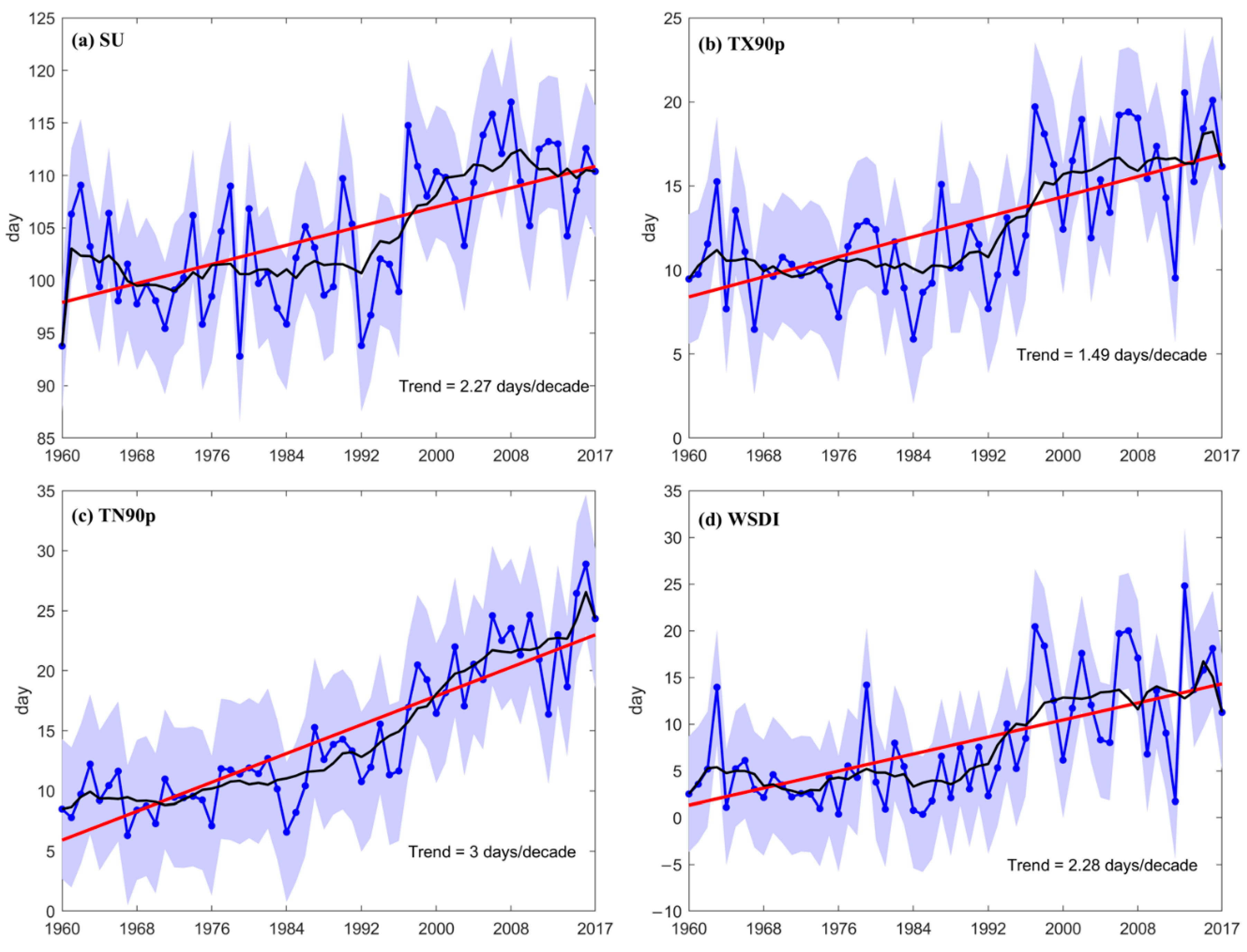
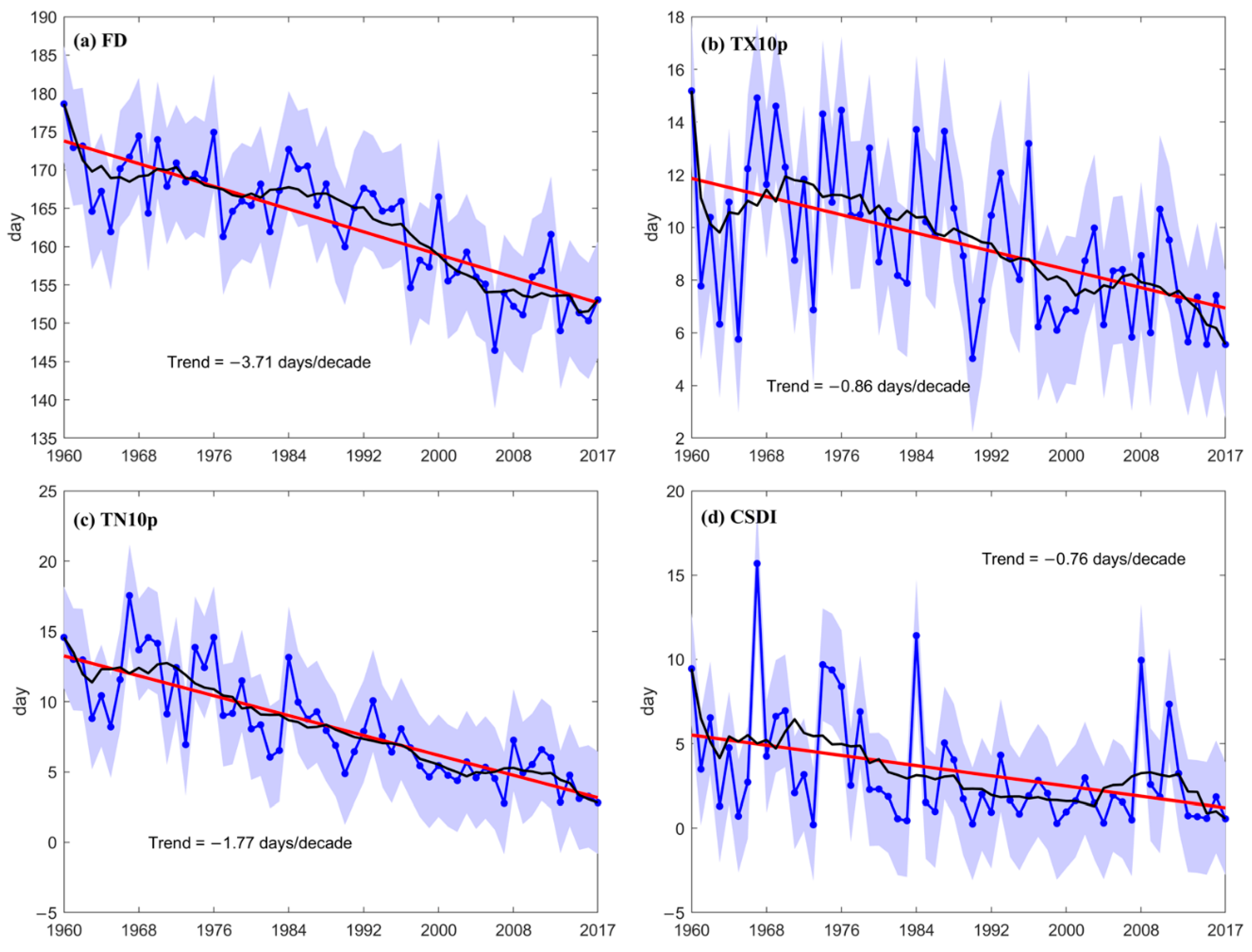
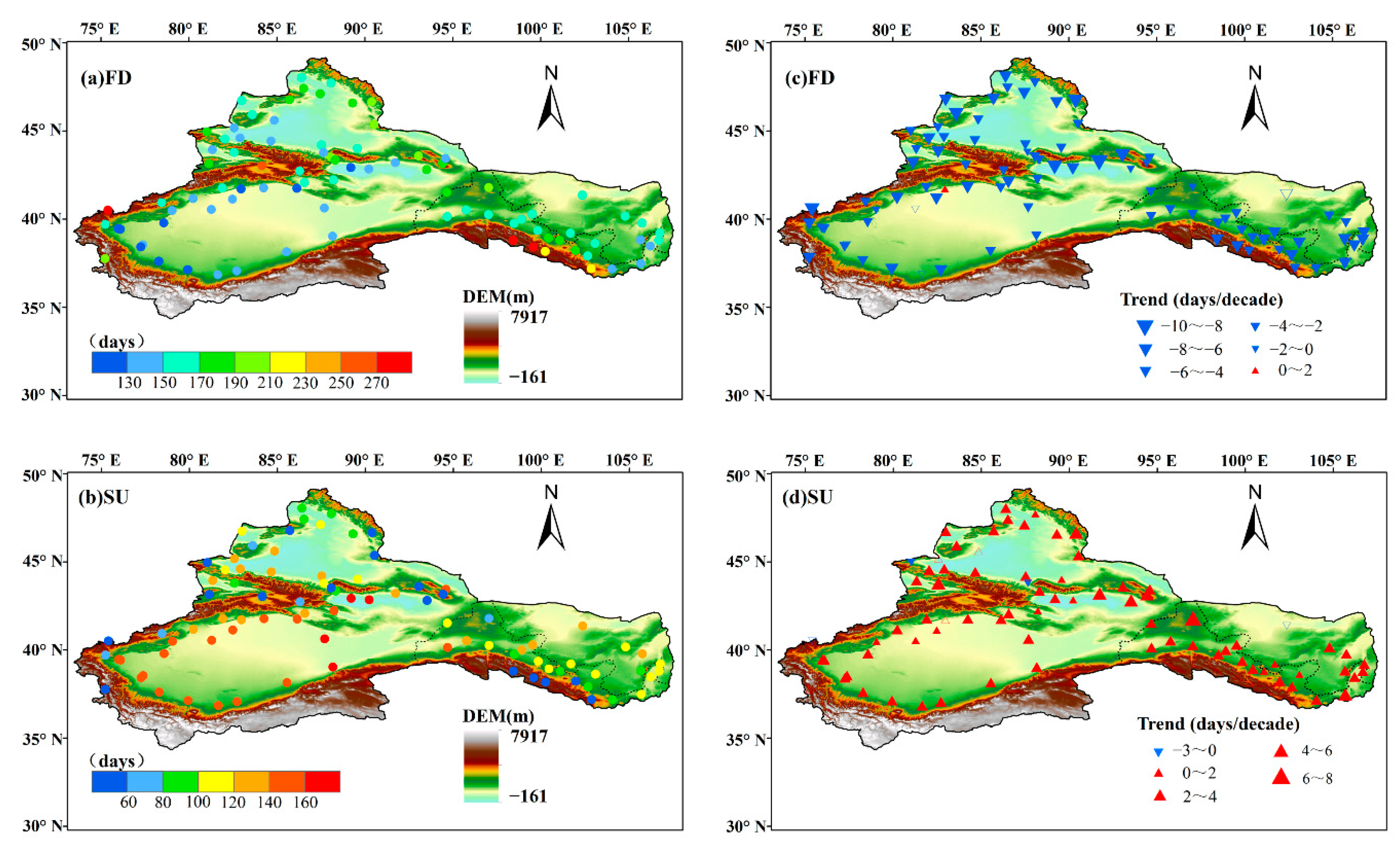

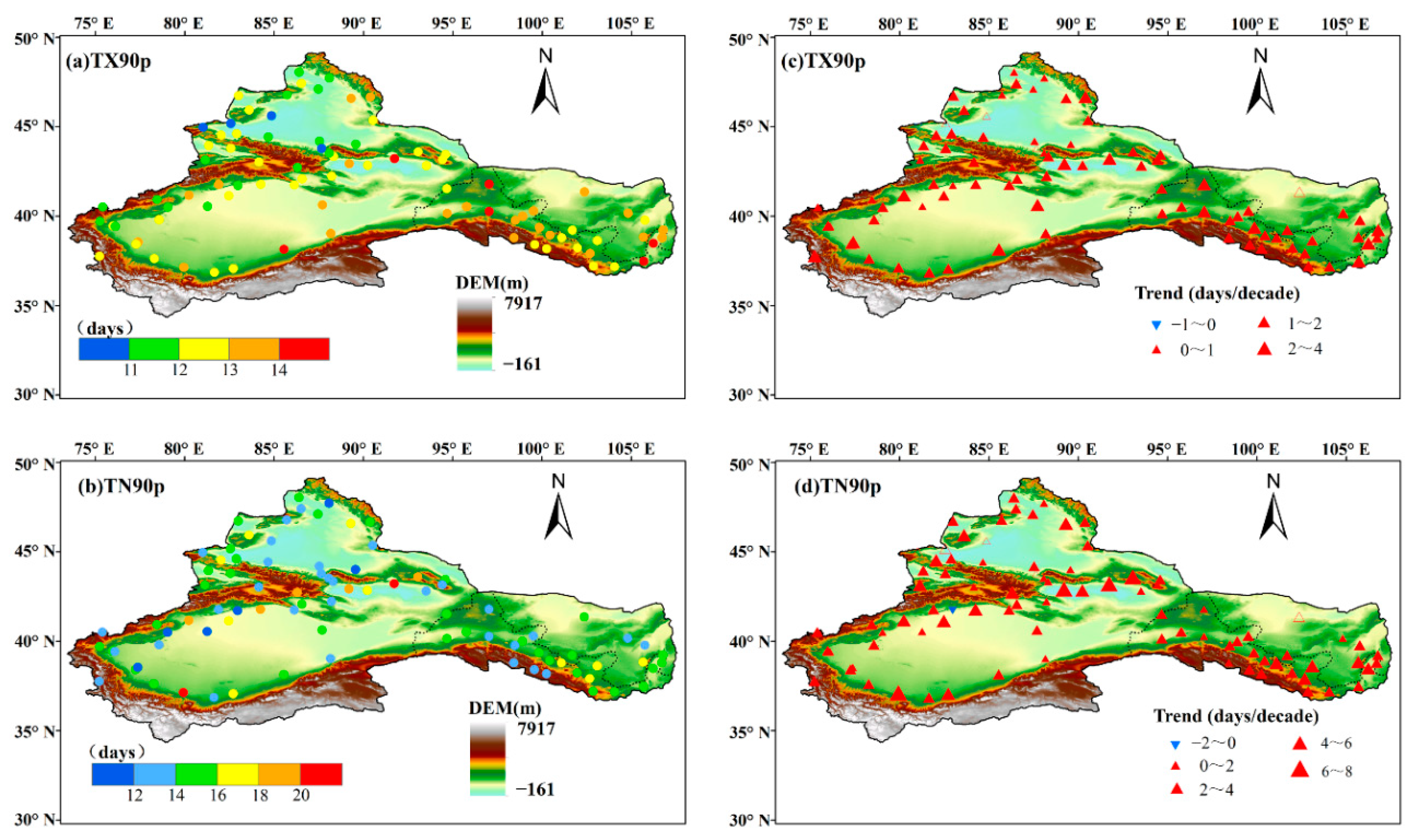
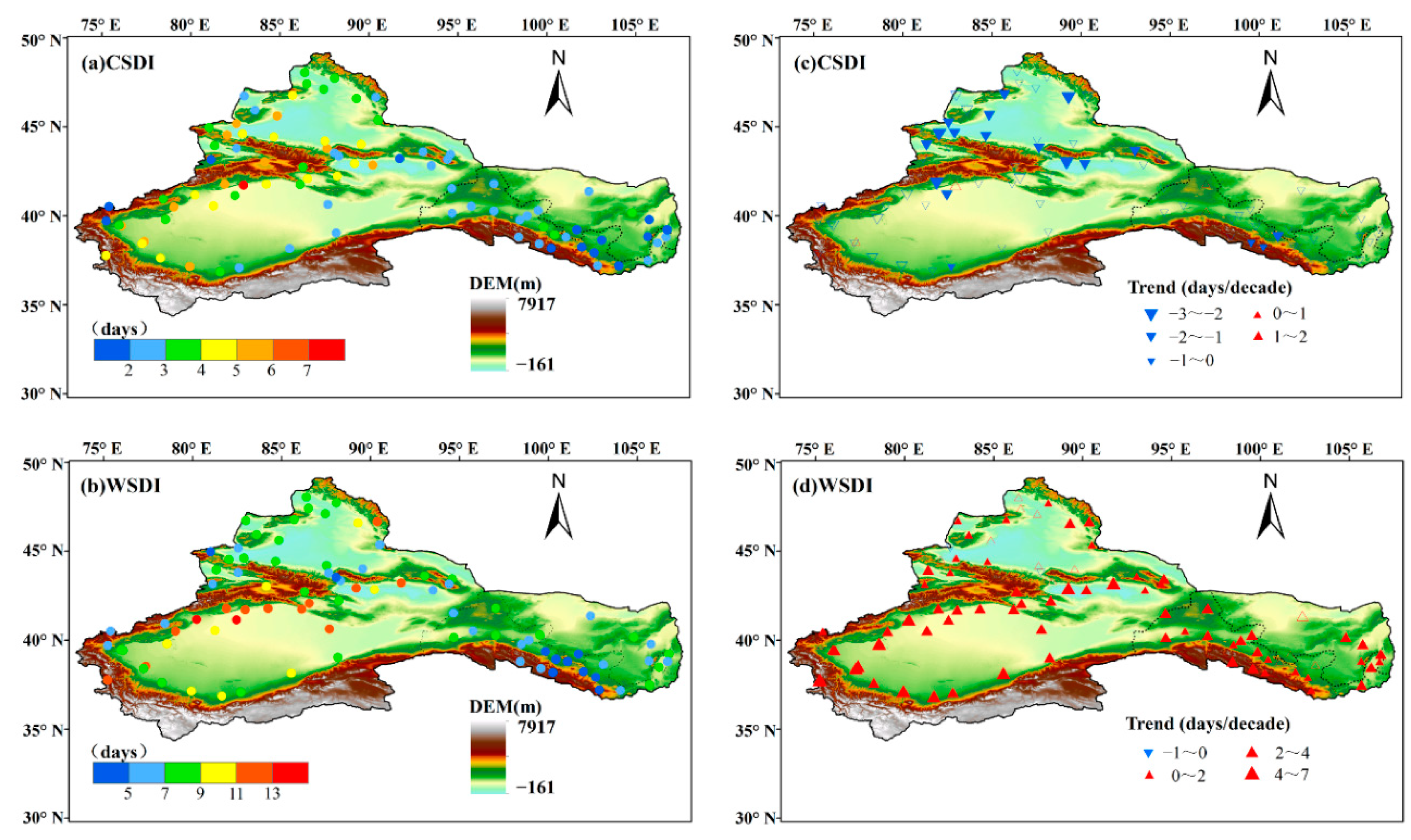
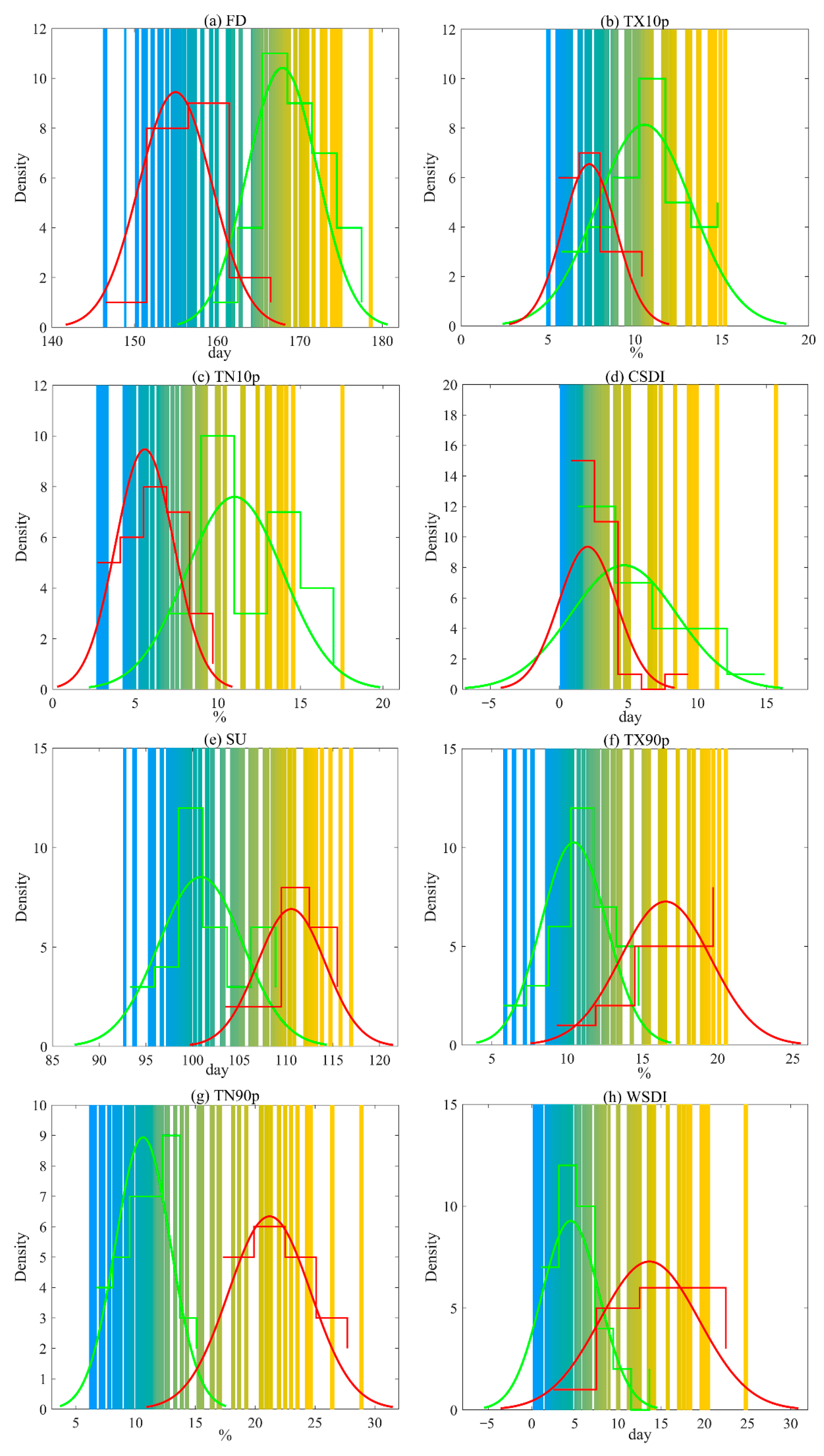

| Categories | Indices | Indicator Name | Definitions |
|---|---|---|---|
| Warm indices | SU25 | Summer days | Annual count when Tmax > 25 °C |
| TX90p | Warm days | Number of days when Tmax > 90th percentile | |
| TN90p | Warm nights | Number of days when Tmin > 90th percentile | |
| WSDI | Warm spell duration indicator | Annual count of days with at least 6 consecutive days when Tmax > 90th percentile | |
| Cold indices | FD | Frost days | Annual count when Tmin < 0 °C |
| TX10p | Cold days | Number of days when Tmax < 10th percentile | |
| TN10p | Cold nights | Number of days when Tmin < 10th percentile | |
| CSDI | Cold spell duration indicator | Annual count of days with at least 6 consecutive days when Tmin < 10th percentile |
| Indices | Increasing Trend | Decreasing Trend | Stationary Trend | ||||
|---|---|---|---|---|---|---|---|
| Total | S | Non-S | Total | S | Non-S | Total | |
| SU25 | 83 | 69 | 14 | 3 | 2 | 1 | 1 |
| TX90p | 86 | 81 | 5 | 1 | 0 | 1 | 0 |
| TN90p | 86 | 85 | 1 | 1 | 1 | 0 | 0 |
| WSDI | 85 | 67 | 18 | 2 | 0 | 2 | 0 |
| FD | 1 | 1 | 0 | 86 | 82 | 4 | 0 |
| TX10p | 1 | 1 | 0 | 86 | 77 | 9 | 0 |
| TN10p | 1 | 1 | 0 | 85 | 82 | 3 | 1 |
| CSDI | 7 | 0 | 7 | 80 | 18 | 62 | 0 |
| Indices | Mann–Kendall | Cumulative Anomaly | MMT | Comprehensive Results |
|---|---|---|---|---|
| SU25 | 1996 | 1996 | 1996 ** | 1996 |
| TX90p | 1996 | 1996 | 1996 ** | 1996 |
| TN90p | 1995 ** | 1996 | 1996 ** | 1996 |
| WSDI | 1995 | 1996 | 1996 * | 1996 |
| FD | 1996 ** | 1988, 1990, 1996 | 1996 * | 1996 |
| TX10p | 1995 | 1995, 1996 | 1996 * | 1996 |
| TN10p | 1990 **, 1991 ** | 1987 | 1987 ** | 1987 |
| CSDI | 1981, 1984 | 1988 | 1988 ** | 1988 |
© 2020 by the authors. Licensee MDPI, Basel, Switzerland. This article is an open access article distributed under the terms and conditions of the Creative Commons Attribution (CC BY) license (http://creativecommons.org/licenses/by/4.0/).
Share and Cite
Pi, Y.; Yu, Y.; Zhang, Y.; Xu, C.; Yu, R. Extreme Temperature Events during 1960–2017 in the Arid Region of Northwest China: Spatiotemporal Dynamics and Associated Large-Scale Atmospheric Circulation. Sustainability 2020, 12, 1198. https://doi.org/10.3390/su12031198
Pi Y, Yu Y, Zhang Y, Xu C, Yu R. Extreme Temperature Events during 1960–2017 in the Arid Region of Northwest China: Spatiotemporal Dynamics and Associated Large-Scale Atmospheric Circulation. Sustainability. 2020; 12(3):1198. https://doi.org/10.3390/su12031198
Chicago/Turabian StylePi, Yuanyue, Yang Yu, Yuqing Zhang, Changchun Xu, and Ruide Yu. 2020. "Extreme Temperature Events during 1960–2017 in the Arid Region of Northwest China: Spatiotemporal Dynamics and Associated Large-Scale Atmospheric Circulation" Sustainability 12, no. 3: 1198. https://doi.org/10.3390/su12031198




